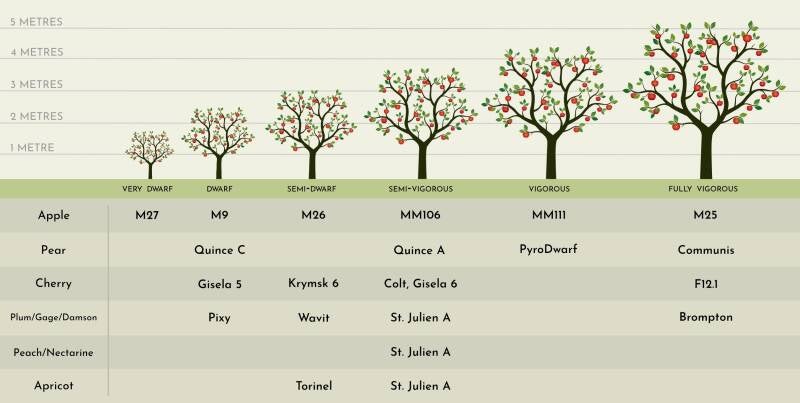
APPLE ROOTSOCK
M9 is a dwarfing apple rootstock that produces a small tree, typically 8-10ft tall. It encourages early fruiting and often results in larger fruit size. However, trees on M9 require permanent staking or support due to their brittle root system and are best suited for good, well-drained soil. It's a popular choice for high-density plantings, small gardens, and various trained forms like cordons and spindlebushes
MM106 is a semi-dwarfing apple rootstock that produces a medium-sized tree, typically reaching about 70% of the size of a standard apple tree (around 3-4.5 meters or 10-15 feet tall). It's a popular choice for home gardens and commercial orchards due to its versatility, good yields, and relatively early fruiting (3-4 years).
MM116 is a semi-dwarfing apple rootstock that produces a tree slightly smaller than MM106 (around 3m or 10ft tall). It's highly valued for its improved resistance to collar rot (Phytophthora) compared to MM106, while maintaining similar productivity. MM116 is adaptable to various soils and generally offers good disease resistance.
M26 is a dwarfing apple rootstock that produces a small tree, typically 2.5-3.5 meters (8-12 feet) tall. It encourages early and heavy fruiting, making it ideal for smaller gardens, containers, or high-density plantings. M26 generally requires permanent staking and prefers fertile, well-drained soil. It is susceptible to collar rot and fire blight.
M27 is an extremely dwarfing apple rootstock, resulting in the smallest possible apple tree, typically around 1.2-1.8 meters (4-6 feet) tall. It promotes very early and abundant fruiting, making it ideal for containers, very small gardens, stepovers, or high-density plantings. M27 requires fertile, well-drained soil, consistent watering, and permanent staking.
P22" is a very dwarfing rootstock for apple trees. It was developed in Poland from a cross between M.9 and Common Antonovka. P.22 is known for producing extremely compact trees (around 15-30% of the size of a standard apple tree), making it ideal for small gardens, container growing, or intensive orchards. It's also recognized for its early fruiting and good resistance to crown and root rots, though it requires permanent support and is susceptible to woolly apple aphid and moderately susceptible to fire blight.
PEAR ROOTSOCK
Kirchensaller is a vigorous, standard pear rootstock originating from Germany, known for producing long-lived pear trees.
PyroDwarf is a semi-vigorous pear rootstock developed in Germany. Despite its name, it's not truly dwarfing like some quince rootstocks, typically producing a pear tree that's about 60-70% the size of a standard seedling tree.
It's known for good compatibility with most pear varieties, excellent winter hardiness, and resistance to lime-induced chlorosis (yellowing due to high soil pH), making it suitable for a wider range of soil conditions than some quince rootstocks. Trees on PyroDwarf are generally precocious, meaning they begin bearing fruit relatively early.
"Kwee Ma" (or "Quince MA") is a semi-vigorous quince rootstock commonly used for pear trees. It results in a medium-sized tree (typically 3-4 meters/10-13 feet), offering a good balance between tree size and productivity. It's known for promoting early and consistent fruiting of large, good-quality pears, and is particularly well-suited for fertile soils.
Kwee MC (or Quince MC) is a semi-dwarfing quince rootstock primarily used for pear trees. Developed at the East Malling Research Station in the UK, it promotes compact growth, early and efficient fruit production, and is widely favored in intensive orchards, especially in the Netherlands and Belgium. It requires permanent support and is reasonably resistant to some diseases but can be susceptible to fireblight and is more frost-sensitive than some other quince rootstocks.
PLUM, PEACH ROOTSOCK
Pixy' is a dwarfing rootstock, meaning it encourages the plum tree to grow to a more manageable size – typically around 8-10 feet (2.5-3 meters) tall at maturity. This makes it ideal for urban gardens, patios, or for those who prefer to prune and manage their trees more easily.
Julian A is a popular semi-vigorous plum rootstock, widely used for plums, peaches, nectarines, and apricots. It produces a medium-sized tree (3-5m) that typically starts fruiting in 5-8 years and doesn't require permanent staking.
CHERRY ROOTSOCK
Gisela 5 is a dwarfing to semi-dwarfing cherry rootstock known for promoting early fruiting and high yields. It's well-suited for high-density plantings due to its compact tree size, which also makes harvesting and pruning easier. Trees on Gisela 5 typically reach about 30-50% of the size of a standard cherry tree.Suitable for pot growing.
COLT rootstock is a semi-vigorous rootstock, meaning it produces a tree of moderate size, typically around 3-5 meters (10-16 feet) tall. It's widely used for both sweet and sour cherries, known for its good anchorage and tolerance to heavier soils. It offers some resistance to diseases like bacterial canker and Phytophthora root rot.
.
